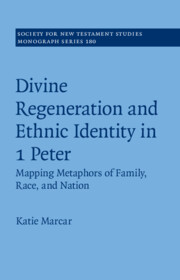Book contents
- Divine Regeneration and Ethnic Identity in 1 Peter
- Society for New Testament Studies
- Divine Regeneration and Ethnic Identity in 1 Peter
- Copyright page
- Dedication
- Contents
- Figures
- Tables
- Acknowledgments
- Note on the Text
- Abbreviations
- Introduction
- 1 Ethnicity Ancient and Modern
- 2 A Field Guide to Metaphors
- 3 The Structure of 1 Peter
- 4 Begotten Anew
- 5 Seed Metaphors in Jewish and Early Christian Literature
- 6 Newborn Babies and Spiritual Milk in 1 Peter 2:1–3
- 7 From House to House of God
- 8 From (Re)Generation to Ethnos
- 9 Conclusion
- Appendix The Language of Rebirth in Rabbinic Judaism
- Bibliography
- Subject Index
- Ancient Sources Index
6 - Newborn Babies and Spiritual Milk in 1 Peter 2:1–3
Published online by Cambridge University Press: 01 June 2022
- Divine Regeneration and Ethnic Identity in 1 Peter
- Society for New Testament Studies
- Divine Regeneration and Ethnic Identity in 1 Peter
- Copyright page
- Dedication
- Contents
- Figures
- Tables
- Acknowledgments
- Note on the Text
- Abbreviations
- Introduction
- 1 Ethnicity Ancient and Modern
- 2 A Field Guide to Metaphors
- 3 The Structure of 1 Peter
- 4 Begotten Anew
- 5 Seed Metaphors in Jewish and Early Christian Literature
- 6 Newborn Babies and Spiritual Milk in 1 Peter 2:1–3
- 7 From House to House of God
- 8 From (Re)Generation to Ethnos
- 9 Conclusion
- Appendix The Language of Rebirth in Rabbinic Judaism
- Bibliography
- Subject Index
- Ancient Sources Index
Summary
In 1 Peter 2:1-3, the author compares believers to newborn babes who are to crave the pure, “wordly” milk in order to grow. This chapter examines the role of breastfeeding in socializing an infant in ancient society. Breastfeeding symbolized an infant’s Jewishness. In 1 Peter, believers’ metaphorical breastfeeding developed their Christian ethnic identity. As a maternal image, this chapter investigates Jewish use of transgender imagery. Though 1 Peter does not call God “mother,” it attributes maternal imagery to God the Father. In Jewish literature, God, and other men, are sometimes depicted with maternal imagery. In the New Testament, Paul describes himself in maternal terms. These traditions illustrate that the Petrine maternal imagery had Jewish and early Christian precedents. Finally, this chapter shows, first, that this Petrine imagery develops the ethnic identity of believers, and, second describes aspects of God’s relationship with believers in terms associated with motherhood. This Petrine imagery is a creative way of communicating theological truths but is still in continuity with Jewish and early Christian traditions.
- Type
- Chapter
- Information
- Divine Regeneration and Ethnic Identity in 1 PeterMapping Metaphors of Family, Race, and Nation, pp. 169 - 197Publisher: Cambridge University PressPrint publication year: 2022

